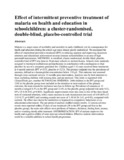| dc.description.abstract | BACKGROUND:
Malaria is a major cause of morbidity and mortality in early childhood, yet its consequences for health and education during the school-age years remain poorly understood. We examined the effect of intermittent preventive treatment (IPT) in reducing anaemia and improving classroom attention and educational achievement in semi-immune schoolchildren in an area of high perennial transmission.
METHODS:
A stratified, cluster-randomised, double-blind, placebo-controlled trial of IPT was done in 30 primary schools in western Kenya. Schools were randomly assigned to treatment (sulfadoxine-pyrimethamine in combination with amodiaquine or dual placebo) by use of a computer-generated list. Children aged 5-18 years received three treatments at 4-month intervals (IPT n=3535, placebo n=3223). The primary endpoint was the prevalence of anaemia, defined as a haemoglobin concentration below 110 g/L. This outcome was assessed through cross-sectional surveys 12 months post-intervention. Analysis was by both intention to treat, excluding children with missing data, and per protocol. This study is registered with ClinicalTrials.gov, number NCT00142246.
FINDINGS:
2604 children in the IPT group and 2302 in the placebo group were included in the intention-to-treat analysis of the primary outcome; the main reason for exclusion was loss to follow-up. Prevalence of anaemia at 12 months averaged 6.3% in the IPT group and 12.6% in the placebo group (adjusted risk ratio 0.52, 95% CI 0.29-0.93; p=0.028). Significant improvements were also seen in two of the class-based tests of sustained attention, with a mean increase in code transmission test score of 6.05 (95% CI 2.83-9.27; p=0.0007) and counting sounds test score of 1.80 (0.19-3.41; p=0.03), compared with controls. No effect was shown for inattentive or hyperactive-compulsive behaviours or on educational achievement. The per-protocol analysis yielded similar results. 23 serious adverse events were reported within 28 days of any treatment (19 in the IPT group and four in the placebo group); the main side-effects were problems of balance, dizziness, feeling faint, nausea, and/or vomiting shortly after treatment.
INTERPRETATION:
IPT of malaria improves the health and cognitive ability of semi-immune schoolchildren. Effective malaria interventions could be a valuable addition to school health programmes | en |

